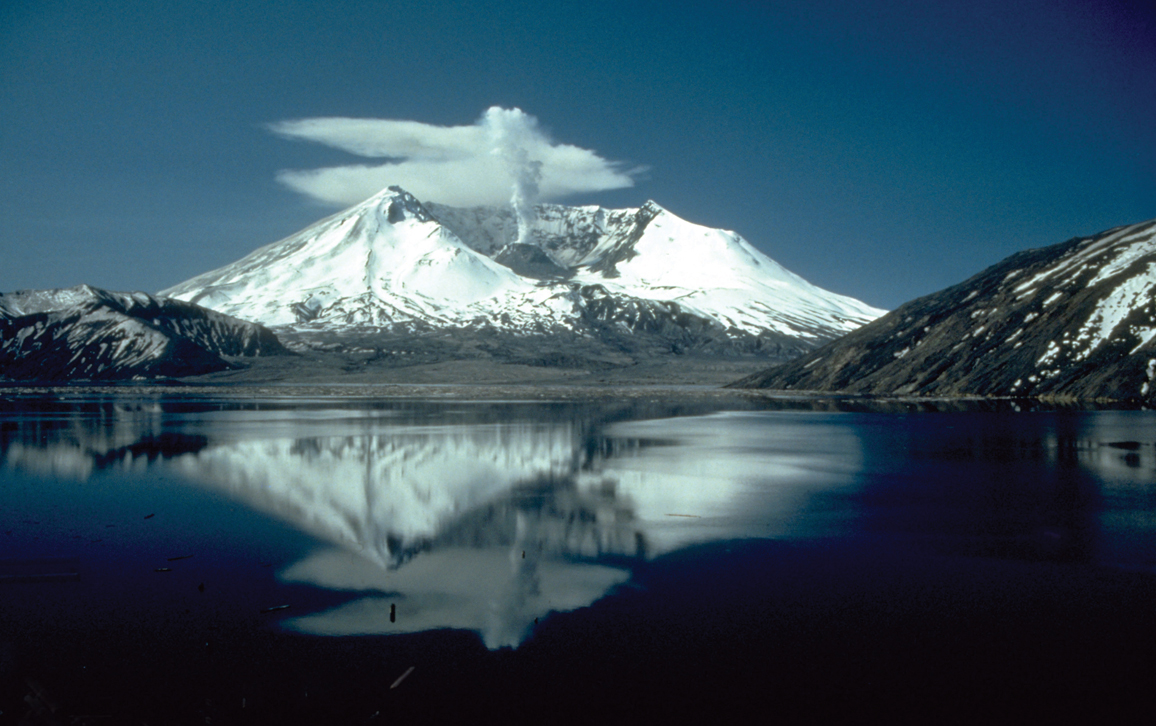
This Article From Issue
March-April 2017
Volume 105, Number 2
Page 122
ERUPTION: The Untold Story of Mount St. Helens. Steve Olson. xviii + 301 pp. W. W. Norton, 2016. $27.95.
On March 20, 1980, after 123 years of dormancy, Mount St. Helens woke up. Seismometers had detected a 4.0 earthquake about a mile below the surface of the volcano, which is located in the Gifford Pinchot National Forest in southwestern Washington. In the days immediately following, more quakes were recorded, as many as 40 an hour. These weren’t aftershocks—it was a volcanic swarm. Business owners, loggers, and the media demanded to know when the volcano was going to blow. As Seattle-based journalist Steve Olson discusses in his book Eruption: The Untold Story of Mount St. Helens, there was no easy answer: The science wasn’t there yet. But as Olson demonstrates, the lack of clear scientific guidance and an absence of straightforward jurisdictional relationships fostered government inaction at all levels, with disastrous results. Given recent seismic activity around Mount St. Helens (earthquake swarms were recorded in June and November of 2016, although these gave no indication of imminent danger), revisiting the events of 1980 seems especially timely.

U.S. Geological Survey (USGS). From Eruption, by Steve Olson, © 2016 Steve Olson. Courtesy of W. W. Norton & Co.
Just after the March 20th quake, some immediate protective measures were taken. The Weyerhaeuser Company, which was harvesting some of the last old-growth timber on its land surrounding Mount St. Helens, evacuated its 300 employees, and the Washington Department of Emergency Services advised everyone within 15 miles of the volcano to leave the area. But within a week, restlessness set in. After all, livelihoods were at stake. Area law enforcement couldn’t keep U.S. Forest Service roads closed to the public indefinitely and, given Weyerhaeuser’s influence in the region, public safety officials dared not close roads on its land.
On March 26, state and local officials, along with U.S. Forest Service personnel, the media, and a Weyerhaeuser representative, gathered in a conference room for a scientific briefing. The presenter, U.S. Geological Survey geologist Donal Mullineaux, along with his colleague Dwight Crandell, had spent two decades studying Mount St. Helens. To the assembled group, Mullineaux reported that for the past thousand years, Mount St. Helens had erupted about once a century—most recently in 1857. Several eruptions had been violent lateral explosions, he noted, which had deposited white pumice as far as six miles away. He went on to describe possible characteristics of a future eruption: The area could be decimated without much warning by pyroclastic flows—powerful air currents of searing gas and pulverized rock capable of traveling at speeds in the hundreds of miles per hour. A landslide could hit the Swift Reservoir, about 10 miles to the south, and trigger a flood. Mudflows might sweep through the river valleys. And although lateral explosions were not well understood at the time, it was possible that another one could occur, blasting massive amounts of rock from the mountaintop directly into adjacent valleys. The next eruption was coming, the geologists had concluded in the report, “perhaps even before the end of this century.”
Dumbfounded by the direness of the warning and the imprecision of the timeline, a state official asked, “You mean to tell us that we as a nation can send a man to the Moon and you can’t predict if a volcano will erupt or not?” That was indeed the case. Mullineaux’s job was to convey the facts based on the geologic history. What to do with the information—whether to reopen roads to the public, for example, or to allow people to return to their homes and jobs—was up to the politicians and emergency planners.
Decisions about how and whether to restrict public access to the area quickly became political. In mid-April, the Forest Service designated two hazard zones. The red zone took in mostly Forest Service land to the north and east of the mountain. Its access was limited to scientists and law enforcement officials. However, an exception was made for lodge owner and newly minted folk hero and media darling Harry Randall Truman, who had lived beside the volcano for 54 years and strenuously defended his right to continue doing so. Refusing to leave, Truman remained in the red zone—no one had the political will to remove him. The blue zone extended to the southwest of the red zone; there, loggers and property owners could come and go during the daytime if they had permission. To the west and northwest of these zones sat prime Weyerhaeuser timberland. The Forest Service had no intention of restricting the lumber company’s property and alienating the powerful employer.
Washington Governor Dixie Lee Ray, a former biology professor who had improbably won the governor’s mansion in 1976 during the post-Watergate political backlash, had final say over the zones’ boundaries. Ray’s contrarian, acerbic personality—she delighted in insulting the press and encouraged Truman to stay despite the wishes of local officials—and her friendship with George Weyerhaeuser, president of the lumber company, made it unlikely that she would extend the blue zone’s boundaries into Weyerhaeuser land, as geologists and law enforcement wanted. The request to expand the blue zone sat on her desk unsigned the morning of May 18, when Mount St. Helens exploded and killed 57 people.
As deftly as he recounts events leading up to the 1980 eruption, the real strength of Olson’s book lies in his handling of what happened after May 18. His reason for writing the book, in fact, is rooted in this period: Reports indicating that victims had flouted the law kindled in Olson a long-standing desire to understand why so many people had been so close to an active volcano.
The idea that the victims are to blame for their own deaths might today be characterized as "alternative fact."
The explanation that Governor Ray and others offered almost immediately afterward, a myth that still persists, was that nearly all were there illegally, having skirted around roadblocks and ignored warnings. Yet Olson found that of the 57 dead—who included campers and hikers, Weyerhaeuser loggers, sightseers, and people monitoring the volcano, such as geologist David Johnston—only Truman lacked permission to be there. In fact, most of the victims were outside the existing blue zone, even as the request to expand it sat on Ray’s desk. Had the disaster happened on a weekday, Olson notes, hundreds of Weyerhaeuser loggers would have been killed in the blue zone (which they had permission to enter during the daytime). None would have been there illegally.
The idea that the victims are to blame for their own deaths, Olson writes, “is the product of a carefully fabricated lie” invented and perpetuated by Ray and other public officials, who were “unwilling to take any blame for the disaster.” They claimed the victims had been warned and shouldn’t have been where they were. Ray stuck firmly to her story, and soon what might today be characterized as an “alternative fact” became, after much retelling, accepted as truth.

U.S. Geological Survey; photo by Lyn Topinka. From Eruption, by Steve Olson, © 2016 Steve Olson. Courtesy of W. W. Norton & Co.
Olson’s anger about this prevarication is justified, and his book builds a solid case for condemning the politicians for their handling of the situation. Those interested in digging further into the details of the cataclysm—scientific, personal, political, and otherwise—will find Richard Waitt’s 2014 title, In the Path of Destruction: Eyewitness Chronicles of Mount St. Helens, an invaluable and sobering read. Waitt, a volcanologist who analyzed ashfalls at Mount St. Helens in the weeks before its eruption, spent 30 years collecting accounts from hundreds of eyewitnesses, including survivors, scientists, rescue and recovery teams, and law enforcement. He rightly believed that these accounts could prove vital to researchers. He also combed through media archives to find the words of the victims themselves, and these make clear how little the public understood about possible hazards.
Finally, Olson discusses the impact of the eruption on the scientific community. Those who had been working at the site were devastated. “Despite all their efforts at monitoring the volcano,” Olson notes, “they were unable to provide any warning of its eruption.” He concludes that
perhaps the greatest failure of the monitoring effort at Mount St. Helens was the insufficient attention devoted to the worst things that could happen. . . . A large event was possible but unlikely, and scientists still have difficulty dealing with low-probability high-consequence events. But without some knowledge of what could happen, the people around the volcano that Sunday morning were unprepared for what did happen.
The U.S. Geological Survey made significant procedural changes in the wake of the cataclysm. Having gained a better appreciation of the demands of conveying scientific knowledge outside scientific circles, the USGS established a new role in its ranks: Information scientists—experts knowledgeable about the data and experienced in media relations—would disseminate information to the press and the public. The agency also developed preparedness plans for hazardous volcanoes and created a standardized volcanic activity alert-notification system, which it modeled after the National Weather Service’s alert system for tornadoes and hurricanes. Its volcanologists also pressed on with renewed vigor. As a result, researchers’ understanding of volcanoes and lateral blasts has increased greatly because of Mount St. Helens—a consequence that should benefit many whenever the mountain rouses again.
American Scientist Comments and Discussion
To discuss our articles or comment on them, please share them and tag American Scientist on social media platforms. Here are links to our profiles on Twitter, Facebook, and LinkedIn.
If we re-share your post, we will moderate comments/discussion following our comments policy.